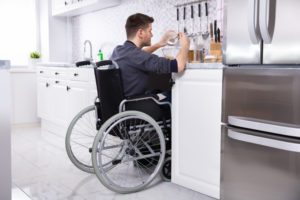 Although 26 percent of people in the United States have a disability, only 6 percent of housing meets basic accessibility requirements. Two in every five older adults experience a disability, and one in five adults are expected to be over 65 by 2030.
Although 26 percent of people in the United States have a disability, only 6 percent of housing meets basic accessibility requirements. Two in every five older adults experience a disability, and one in five adults are expected to be over 65 by 2030.
Many people with disabilities struggle to afford housing that meets their needs. For those receiving Supplemental Security Insurance (SSI), the cost of rent for a modest apartment in many areas can exceed their income, the National Low Income Housing Coalition reports.
When accessible residences are unavailable, individuals may feel institutionalized living is their only option. Yet most would prefer to reside in community settings.
Features of accessible housing include lowered counters, widened doorways, and zero-step showers. Adaptable housing can be modified to suit the needs of those with disabilities.
Location is also important for accessibility. Reasonably priced housing in communities with inexpensive public transportation and walkable or rollable sidewalks promote independence and allow individuals to remain active in their communities. Living and engaging with one’s community can also prevent isolation and loneliness.
In an effort to address the need for accessible and affordable housing for people with disabilities, Senator Bob Casey (D-PA) introduced the Visitable Inclusive Tax Credits for Accessible Living (VITAL) Act in April 2023. This legislation aims to increase investment in the federal Low-Income Housing Tax Credit (LIHTC) Program to address the housing needs of aging people and individuals with disabilities.
The Low-Income Housing Tax Credit (LIHTC) Program
The LIHTC program incentivizes developers to build new housing for low-income renters through tax credits. Individuals can obtain LIHTC units when they meet location-specific income requirements.
The VITAL Act modifies the LIHTC program to increase the number of accessible homes and residences in navigable communities. This would provide more residential options for adults with disabilities, helping them remain in communities.
Highlights of the VITAL Act
If adopted, the VITAL Act would change the LIHTC program in the following ways:
- It would increase the overall funding for LIHTC for both the 4 percent and the 9 percent tax credits.The 4 percent tax credit, known as the 30 percent subsidy, supports the rehabilitation of existing buildings or new construction financed by tax-exempt bonds. The Act would decrease the tax-exempt bond financing requirement from 50 percent to 25 percent, allowing states to allocate more 4 percent credits for building rehabilitations.The 9 percent tax credit, known as the 70 percent subsidy, which supports new construction and substantial rehabilitation without federal support, would increase 50 percent over the 2021 level.
- The Act would make more funding available for developers who build units for those with disabilities in accessible communities. It would give 130 percent more credits to developers who create adaptable and accessible units in areas with good EPA walkability scores. Developers would therefore pay fewer taxes.
- The legislation would impose requirements on the percentage of accessible units constructed under LIHTC in a three-year period. Forty percent must be adaptable and accessible for residents with disabilities. Or, if these units are located in walkable and rollable areas, states may lower the minimum to 20 percent. This incentivizes creating units in navigable areas, improving residents’ quality of life.
- The program would give each state housing finance authority $150,000 annually. The funds would support the creation of LITHC resource centers for new and nonprofit developers.
- The VITAL Act would establish a housing national advisory council. Comprising community-based organizations, housing developers, state housing finance agencies, investors, and the research community, this council would report on national trends and best practices for the program. The report would be available to states and the Secretary of Housing and Urban Development to review every three years.
If the VITAL Act becomes law, it could help support the housing needs of the aging and disabled population. Consult with a special needs planning attorney near you to learn more about applying for LIHTC housing.

Recent Comments